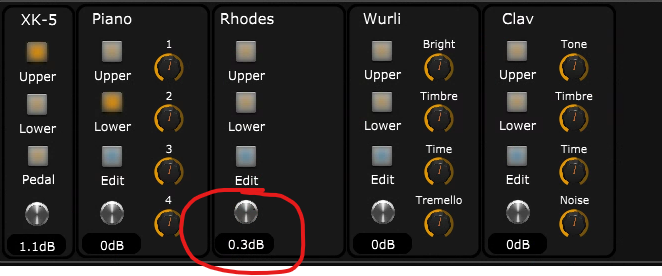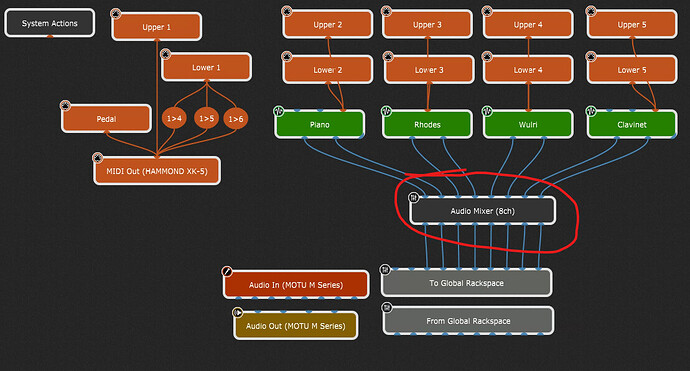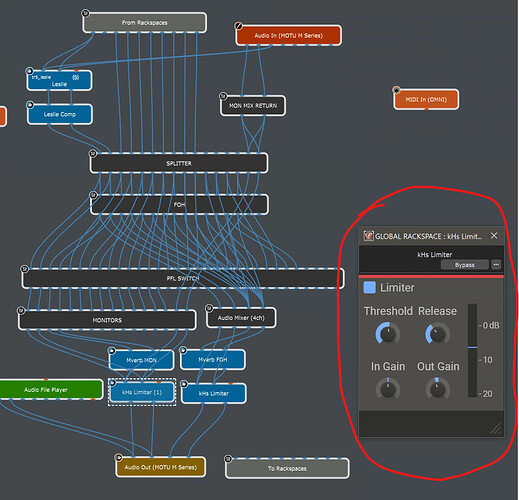-18 db. That should be your target.
This means that your average normal volume should hit around -18db when playing. If you’re playing softer, lower than this. Your max volume shouldn’t be more than 3-4 db hotter than -18db.
This to me is the magic number because it keeps you well away from clipping your signal and since you are comming out digital, you don’t need to worry about signal to noise ratios. Your sounds should all be prestine. Even in my rig where one of my sound sources is a Hammond XK-5 organ into my interface, I route this through GP, into a digital Leslie and back out of GP and there is no signal to noise issues and that signal path stays -18db on average.
The worst thing you can do to a digital signal is clip it.
Here’s my global rackspace. The white lines next to the meters mark -18db and I calibrated this wtih a tone generator and that mark’s position is dependant on the visual scale you make your meter widget so calibrate after you make your design and move the white line to match the meter:
I have dedicated busses for my main instruments and some VST ‘aux’ channels too. I usually never touch these faders but I can attinuate a bit here if it need to.
I also have main faders for my in-ears and for my FOH sends. My levels should look the same across the board. If my Piano is hiting at -18db, so is my FOH buss. If my Organ and Piano are both at -18db, so is my FOH. There might be a tiny amount of additive gain when combinding sounds but nothing that would drive thigns into the danger zone.
Here’s an example of my local rackspace:
I set the volume wtihin the VSTs if needed to target -18db then I can adjust in this mixer block to get the balance right between VSTs or adjust per song wtih widget control. Here’s the panel:

I have a volume knob that controls the gain stage in the mixer block and I can see how it’s adjusted.
I want to start with a strong clean and balanced output from my VST that hits around -18db, then I never want to boost that more than 1-3 db and more often than not I cut it by a bit. I do this once wtih the global rackspace mixer being only used to subtract gain if I need to.
Back in the global I have per channel control of the signal volume to my in-ears and to FOH so I can make my piano louder to only me for instance and I have the ablity to switch if this gain for my monitors is pre-fader level or post fader level. That’s a bit fancy but I keep it quite simple.
My global wiring has a simple Limiter in the final output stage. This is set to just tuck down any errant over driven signals… It basically never get’s used. I’ve tried a few different ones but this simple one my kHz is nice:
Lastly, I don’t use compression (except a tiny amount of optical compression on my digial Leslie) becaue franky most VSTs don’t need it, it causes me to lose the dynamics I like and it causes me to turn things up louder. You can get too far down a rabbit hole with compression.
I come out of my interface into a nice pair of direct boxes so FOH can take a balanced line level signal. For my in-ears, I come out into a Rolls headphone amplifier and I adjust my personal level there 99% of the time. That Rolls even has a microphone in so I can run my vocal mic into that and pass it through to FOH and then I can easily add more of ‘me’ to my ear mix. Or, if you don’t sing you could put a condenser mic into that Rolls and have your own stage mic to blend in to taste… if you use ears.
I hope this helps. In general, don’t rely on a limiter/compression but do have one for safety at the very end of the line. -18db is a very good target to follow.
I had a very good first outing with GP but I have refined a lot since that first gig and I find less is more.


